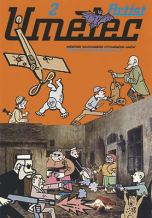| Umělec 2011/2 >> How to Commit Telepathy | Просмотр всех номеров | ||||||||||||
|
|||||||||||||
How to Commit TelepathyUmělec 2011/201.02.2011 Jim Hollands | User Guide | en cs de |
|||||||||||||
|
Control of your mind is a military capability.
Telepathy, from the Greek τελε, tele meaning “remote” and πάθεια, patheia meaning “to be affected by”, describes the transfer of information on thoughts between individuals by means other than the five classical senses. The term was coined in 1882 by the classical scholar Frederic Myers to replace the earlier expression thought-transference. A person who is able to make use of telepathy is said to be able to read the minds of others. It is a deliberate act in the same way that spoken conversation is a deliberate act. Telepathy is, furthermore, a figure of communication - of the communication of feeling or “felt” meaning (pathos) over distance (tele). Thought insertion/removal is a symptom of psychosis, particularly of schizophrenia or schizoaffective disorder. Psychiatric patients who experience this symptom falsely believe that some of their thoughts are not their own and that others (e.g., other people, aliens, or conspiring intelligence agencies) are putting thoughts into their minds (thought insertion). Some patients feel as if thoughts are being taken out of their minds or deleted (thought removal). Along with other symptoms of psychosis, delusions of thought insertion may be reduced by antipsychotic medication. Psychological symbiosis is a less well established concept. It is an idea found in the writings of early psychoanalysts, such as Melanie Klein. It entails the belief that in the early psychological experience of the child (during earliest infancy), the child is unable to tell the difference between his or her own mind, on one hand, and his or her experience of the mother/parent, on the other hand. This state of mind is called psychological symbiosis; with development, it ends, but, purportedly, aspects of it can still be detected in the psychological functioning of the adult. Putatively, the experience of either thought insertion /removal or unconscious memories of psychological symbiosis may have led to the invention of “telepathy” as a notion and the belief that telepathy exists. Psychiatrists and clinical psychologists believe and empirical findings support the idea that people with schizotypal personality disorder are particularly likely to believe in telepathy. What is commonly thought of as telepathy will, I have no doubt, be achieved this century. Instead of communicating by speech as we do presently, we’ll be able to think to each other, simply by implants connected to our nervous system linking our brains electronically together, possibly even over the internet. It will completely change what it means to be human. We won’t need the languages that we presently do, we’ll need a new language of ideas and concepts in order to communicate thoughts from brain to brain. Lyrics and the written word will be used to more clearly denote what is going on using telepathic feelings and it means that they are both equally important. By creating a virtual environment we create a completely objective environment A key to telepathy is to “be present”. That is, be “here” and be “now”. Still your mind. Do not think of any other place. Do not think of the past or the future. This is the hardest part of telepathy. You remove the messenger and take the message. This technique attacks the immune system. I think what we are doing is shifting the boundary, not making things transparent. Instead of lying by speech, you will lie by thought. Poetry, literature, music and painting will dramatically change. Unless we think it is humanity itself that changes by becoming a telepathic. At present our method of communication - speech - is very slow, serial and error prone. The potential to communicate by means of thought signals alone is a very exciting one. We will probably have to learn how to communicate well in this way though, in particular how to send ideas to one another. It is not clear whether if I think about an ice cream watch these rap niggaz get all up in your guts my thoughts roughly the same as yours - that my thoughts are roughly the same as yours. We will have to learn about each other’s thoughts. Maybe it will be easier than we think, maybe not. Certainly speech is an old fashioned, out dated means of communication. We are approaching a psychic singularity, the psychic impact of an ontology of being. We cannot prevent the singularity, that it is coming is an inevitable consequence of humans’ natural competitiveness and the possibilities inherent in technology. The Stargate Project was the umbrella code name of one of several sub-projects established by the U.S. Federal Government to investigate the reality, and potential military and domestic applications, of psychic phenomena, particularly “remote viewing”: the purported ability to psychically “see” events, sites, or information from a great distance. These projects were active from the 1970s through 1995, and followed up early psychic research done at The Stanford Research Institute (SRI), The American Society for Psychical Research, and other psychical research labs. Currently the U.S. military is funding synthetic telepathy using noninvasive brain imaging technology like electroencephalography to let people communicate thoughts to each other. The Pentagon’s division Darpa’s budget for the next fiscal year includes $4 million to start up a program called Silent Talk. The goal is to allow ‘user-to-user communication on the battlefield without the use of vocalized speech through analysis of neural signals.’ In 2008, the National Research Council and the Defense Intelligence Agency released a report suggesting that neuroscience might also be useful to ‘make the enemy obey our commands.’ For example, a soldier would ‘think’ a message to be transmitted and a computer-based speech recognition system would decode the EEG signals. The decoded thoughts, in essence translated brain waves, are transmitted using a system that points in the direction of the intended target. Here are some techniques used by the Star Gate Project: The Cinema Method of clearing ones mind, using remote viewing as moving pictures, is a fundamental next step. When watching the cinema screen, we all stop talking to ourselves. This switches off the internal dialogue, the incessant mental conversation that we have inside our heads. Mental silence is the second major initiator of remote viewing (RV) Clearing the mind by focusing Directed Attention on RV is the most powerful way of developing RMCT(remote mind control technology) Directed Attention is the guided use of perception to study RV. Once Directed Attention has been set up, it can be used for RV of distant locations. Command the thalamus to let all sensory data through. Go systematically through all six senses (remote viewing/ESP is the sixth) and clean all the data channels. See your attention as a bright star epicentred in your thalamus. Command the epicentre of attention to shine a bright white light of perception into the thalamus, that becomes coherent and focuses down into the mental laser light of directed attention. Command this mental laser to illuminate your entire thalamus and focus on the goal of remote viewing. Command your thalamus to give you an unlimited attention span; to eliminate all negative programmes; to engage all unused neurons and neuronal networks, so as to boost your attention to directed attention; and then elevate this directed attention to fixate on remote-viewing data being received by your biophysical vehicle. Now use this directed attention laser to inscribe a cinema screen in lines of blue fire, drawn in a clockwise direction, in your mind’s eye. This is the cinema screen, upon which you will see the remote-viewing picture relayed to you by your biophysical field located at the remotely-viewed target site. Once you have drawn the cinema screen, fill it with blue fire; see a blue screen of lambent energy which now faces your mental gaze. Then visualize your directed attention travelling from your thalamus, through the cinema screen, which is the doorway into the biophysical realm. As this occurs, visualize the screen becoming transparent, a perfect medium for the information you will pick up from your biophysical field. This practice initiates your biophysical consciousness to become aware of the outside world. The mental cinema screen can be thought of as the entrance to the world of psi; simply by stepping through it, your attention can be transported to anywhere you wish to go. It is a magic doorway to the great beyond. Next, practice your remote viewing from this state of consciousness. Use this ‘magic doorway’ approach to remote viewing and project your awareness to the places you wish to psychically view. With practice, every time you engage directed attention on the cinema screen, your brain and biophysical fields will automatically engage the cinema method programme. By positive feedback, the practice of directed attention will make you more and more efficient at ERV(extended remote viewing). Use directed attention to inscribe the cinema screen and will your biophysical field to travel to the target to be remotely viewed. Use the mental laser light of directed attention as the cursor in the biophysical cyberspace of your paranormal world, to direct your biophysical field to the target. Once at the target site, command your biophysical field to transmit information, via its quantum computer link to your brain, to your cinema screen. This technique can be used to enter into remote-viewing bilocation, where you feel you are actually at the target site, as if you were in a lucid dream. This strong intersubject correlation shows that, despite the completely free viewing of dynamical, complex scenes, individual brains “tick together” in synchronized spatiotemporal patterns when exposed to the same visual environment. Our data suggests that achieving a tight control over viewers’ brains during a movie requires, in most cases, intentional construction of the film’s sequence through aesthetic means. In the mid 1990’s, Dr. Stuart Hameroff at the University of Arizona, and Oxford’s Sir Roger Penrose proposed that quantum processes might be involved in the emergence of human consciousness. Penrose is well known for his work in mathematics and the physics of black holes. The idea of creating a synthesis of quantum teleportation and brain function quickly followed as a theory of telepathy. In the Penrose-Hameroff theory, the shape of certain structures in the brain are controlled by the location of single electrons, the quantum of electric charge, and these structures resemble quantum computing circuits. There is no place for dissent or independence research. The troublesome artist will be eliminated or absorbed. The elite lives happily ever after at the top of a control state that makes 1984 look cozy and nostalgic. The word telepathy is misleading. Organic communication would be a more accurate designation, since the whole organism is involved. You transmit and receive as much with your big toe as you do with your brain and what is transmitted is a strong emotional reaction, not neural data like triangles, circles and squares. In order to prepare oneself for telepathic communication, first of all clear your mind. You can do this by closing your eyes and taking a nice, deep breath. Release the breath slowly. Continue this, and begin to count the exhalation. Take nice, easy, slow breaths. Continue counting to 20. Disregard sensory data, thoughts, emotions, and the like. Repeat as necessary. This method is good because it gives your conscious mind something to do while calming your subconscious mind. Alternatively pretend that some sound will occur in the future, and just listen for it. For a short time, your consciousness will stop all processing and go into a quiesced state. As you practice, increase the length of time that you listen. Then you have to find your target’s mind. The first method you can use is to recall information about your target. To do so, you could remember the feeling that person gave you upon meeting. If you spoke to the person, you could remember their voice or vocal tones, and Send to the person with that particular voice. You could also recall their physical appearance. One method the Russians were fond of in their experiments was mentally visualizing the target’s face or physical body. Pinging is a way to send a small message to a person, usually fun ‘hallo!’s or facepalm or something. The most common and simple way to ping a person is thinking at them. The first step is acquiring the target. The second step is thinking while directing your thoughts at this person. One method of this is sub-vocalization. Sub-vocalization is thinking with the intent to speak, or thinking just below the vocal level. To send a simple ping, one would simply think a concept at a person. In order to add strength to a ping, it is common to send a burst of energy towards the target at the same time as the ping. Pulse Sending is sending short messages. Pulse Sending as a process is very simple, however, the process is such that it can only send very short, simple concepts, in order to do so in rate with the heartbeat. The Russians used this to communicate with submarines deep under pack ice. The result was a clear message, due to both the simplicity of the concept and the repetitive sending of such. The nature of Pulse Sending is such that it can be done quickly and efficiently, with very little preparation or skill. There is only one real way to go about Pulse Sending, and that can be detailed in steps. The first step is, as in all telepathic applications, to identify a target. Once you have identified the target, you should focus on what you want to Send. For instructional purposes, we will use the example of the color Red. Once you have identified both a target and a signal to send, begin thinking, like in pinging, at the target. Mentally “push forward” at the target, while visualizing the target’s face. Push forward each time your heart beats, for 20 seconds. Wait 5 seconds, and repeat. Broadcasting can be used to influence large crowds, because it can send information in a “field” around someone. This method is extremely useful for releasing information to an area or a group, as it is much more efficient than Sending to each person, and is often used in times of panic, as it is a natural survival method. Humans instinctively broadcast emergencies, whether they like it or not. One method for Broadcasting is very simply “mentally shouting.” If you’re familiar with your mental voice, and we all should be, because it is the fundamental basis of human thought, this is simply changing that voice from a normal talk to a loud shouting. If done properly, there should be a pressure or rising feeling at or moving to the top of the head. This may take a while to develop, but shouldn’t be longer than a matter of seconds. Another method of Broadcasting is something we do very often. Stewing, or thinking single-mindedly about a single thing, is a form of broadcasting, and should be picked up by various sensitives and even semi-sensitive Nons in the area. The third and final method is one you’ve been expecting, simply Sending at a region. Espionage is the primary use for Scanning and Probing. Scanning and Probing are both methods of getting information from a target, potentially an enemy, without their immediate consent. Another primary use of Scanning, not as much so Probing, is determining energetic information of another individual, be it friend or foe. This is the general concept understood when one says Mind Reading, specifically how a person gains unchecked access to information from an individual, whether the person is presently thinking it or not. The first step here is acquiring the target. For this particular exercise, you should begin by extending a tendril from the edge of your mind or shields. This process is difficult to describe, but can be done using the visualization method amongst those who have programmed their subconscious to manipulate Psi and perform acts based on biofeedback. Reach the tendril towards the target, gently, because a forceful scan/probe can be extremely painful, and less than covert. For a cursory scan of surface thoughts, simply brush the tendril against the edge of the target’s mind, or energy field. For a probe, push the tendril into the mind, rooting around and navigating to find what you want. Suggestion is a simple application of telepathic Sending. Suggesting can be performed by use of the Pulse Sending method. The difference is, in Suggestion, the object is to have the target perform an action, summarily, basic mind control. The first step, as always, is to acquire the target. Once you have acquired the target, begin pulse-sending the concept of the action. In this case “Worldwide General Strike 12/12/12” While doing this, vividly picture the target not getting out of bed on 12/12/12. Another method of doing this would be Sending “You wish to strike” or, mimicking their mental voice, “I would like to strike on 12/12/12.” If you wish to Send complex instructions to the target, walk them through the process step by step, or if the action includes several logical steps, suggest to them that they want the result, while visualizing them performing the steps. Projection is the “Broadcasting” of Suggestion. While suggestion is suggesting to a single person to perform an action, Projection is the Sending of sensory input to a region. For this example, we will project the illusion of David Cameron having a heart attack. To do this, a target person is not necessary, but rather a target location, in this case, 10 Downing Street. Once you have determined a location broadcast the image or thought of David Cameron dying. Actually see the person, while broadcasting the image of it to 10 Downing Street. While people may not see it immediately, people will act as if they see it. As another example, if someone were to project a bomb in the 10 Downing Street, the people in the area may move to avoid that area (consciously or subconsciously, depending on their level of sensitivity to telepathic Sending), or even act afraid of it. However, it seems the older you get (especially if you drink regularly), the more your reception deteriorates in quality. Still, last week, I was standing at the bar and I suddenly had this crystal clear thought, “IT MUST BE FUN TO ROB A BANK.” Then this guy next to me turns round to his girlfriend and says, “I’d love to rob a bank”. It’s like a psychic Mexican wave. The “telepathic structure” thus becomes the thought of the literary text as reading-machine, as reading-effect, that is as always in advance including, foreseeing, its addressee... without knowing where it is going, who is speaking or who is listening, and at what distance. Telepathy or second sight is in essence a metaphor for reading. Dismantle the wall between an author and their work. Telepathy is a topic which is closely bound up with psychoanalysis, but with which psychoanalysis cannot come to terms. The question of telepathy shakes psychoanalysis to its core. It is difficult to believe a theory of the unconscious without a theory of telepathy. They can be neither confused nor disassociated. Telepathy is a foreign body within psychoanalysis. Telepathy is part of, and inexorably linked to, an explosion of telemedia and teleculture. If psychoanalysis disturbs and even traumatises reason’s relation to itself, then think what telepathy can do. I’m thinking of a brick wall. Think of a brick wall. A brick wall.
01.02.2011
Рекомендуемые статьи
|
|||||||||||||
|
04.02.2020 10:17
Letošní 50. ročník Art Basel přilákal celkem 93 000 návštěvníků a sběratelů z 80 zemí světa. 290 prémiových galerií představilo umělecká díla od počátku 20. století až po současnost. Hlavní sektor přehlídky, tradičně v prvním patře výstavního prostoru, představil 232 předních galerií z celého světa nabízející umění nejvyšší kvality. Veletrh ukázal vzestupný trend prodeje prostřednictvím galerií jak soukromým sbírkám, tak i institucím. Kromě hlavního veletrhu stály za návštěvu i ty přidružené: Volta, Liste a Photo Basel, k tomu doprovodné programy a výstavy v místních institucích, které kvalitou daleko přesahují hranice města tj. Kunsthalle Basel, Kunstmuseum, Tinguely muzeum nebo Fondation Beyeler.
|




































 We Are Rising National Gallery For You! Go to Kyjov by Krásná Lípa no.37.
We Are Rising National Gallery For You! Go to Kyjov by Krásná Lípa no.37.
Комментарии
Добавить новый комментарий